Go to 1° Unipartite Upper Beaks
Go to 2° Unipartite Upper Beaks
Go to 3° Unipartite Upper Beaks
SURVEY OF UNIPARTITE UPPER BEAKS
1° Unipartite Beaks
Included here are four families (one questionable): Ommastrephidae, Thysanoteuthidae and Loliginidae, Architeuthidae (?).
ORDER - OEGOPSIDA:
OMMASTREPHIDAE: 11 genera
UPPER BEAK CHARACTERISTICS
- Step: Absent.
- Shoulder Blade: Thick; occupies most of Outer Part of Shoulder but is partially covered laterally by thin layer of hyaline material.
- Shoulder Blade: Consists of two Components (Inner and Outer). Inner Component forms separately from Outer Component and pigmented Lateral Wall. Components fuse although a line separating them is visible in a cut. The Outer Component is continuous posteriorly with the Free Shoulder and the Inner Component extends posteriorly onto the Sessile Shoulder.
- Hyaline Matrix: Forms Inner Part of Shoulder; there is no Middle Part.
- Palatoshoulder Ridge: Absent.
- Pigmentation of posterior surface of Hyaline Matrix: During ontogeny pigmentation of Inner Component extends posteriorly onto lateral surface of Hyaline Matrix before pigmentation of posterior Lateral Wall reaches this point. This pigment is NOT continuous dorsally with that of the Bridge.
- Yellow line: Present. May be difficult to see in heavily pigmented beaks.
OMMASTREPHIDAE: Ommastrephinae: 6 genera
ARROW - Inner Component of the Shoulder Blade.
The Left image shows the initial posterior Pigmentation of the Hyaline Matrix resulting from the development of the Inner Component of the Shoulder Blade. The Middle image shows the absence of a Step, the presence of a Yellow Line and the convex shape of the anterior edge of the Shoulder Blade; the white material at the anterior end of the Yellow Line is the material of the Yellow Line. The four prominent ridges on the Palate (Right image) are characteristric of most Ommastrephinae. Their relationship to a Palatoshoulder Ridge is uncertain; however, there is no Palatoshoulder Ridge on the Shoulder.
Sthenoteuthis is treated at length on the 1° Unipartite page.
OMMASTREPHIDAE: Todarodinae: 4 genera
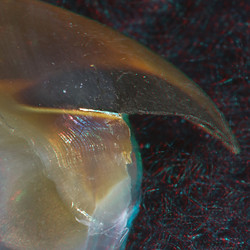 |  | 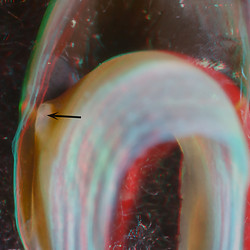 |
| Nototodarus hawaiiensis, 102 mm ML, 3.4 mm URL. LEFT - Side view of shoulder region. MIDDLE - Oblique view. RIGHT - Posterior view. | ||
ARROWS: White - Broad fold of the Lateral Wall. Black - Unpigmented Shoulder region of Hyaline Matrix extending from the medial side of the Shoulder (MIDDLE) to the posterior end of the middle shoulder (RIGHT). Top-yellow - Outer Component of the Shoulder Blade. Bottom-yellow - Inner Component of the Shoulder Blade.
The Left image shows the absence of a Step, the presence of a Yellow Line and a convex shape (although a bit damaged) to the anterior edge of the Shoulder. The Middle image shows the absence of a Palatoshoulder Ridge and the two Components of the Shoulder Blade (yellow arrows). The Right image shows the last part of posterior surface of the Hyaline Matrix that has not been pigmented; this white, oval region above the junction of the Free and Sessile Shoulders is characteristic of many Unipartite beaks.
Nototodarus is treated at length on the 1° Unipartite page.
OMMASTREPHIDAE: Ornithoteuthis. Illicinae: 1 genus
 |  | 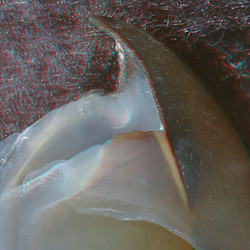 |
| Ornithoteuthis antillarum, male, 196 mm ML, 5.9 mm URL. LEFT - Oblique view. | Illex illecebrosus, female, 162 mm ML, 3.6 mm URL. MIDDLE - Side view. RIGHT - Oblique view. | |
Ornithoteuthis (Left image) may be an early offshoot of the Ommastrephinae clade (Roeleveld,1988; however, see Wakabayashi et al, 1012); as such, its beak may have retained a primitive feature, i. e., a remnant of a Palatoshoulder Ridge (arrow). The Middle image shows the absence of a Step, the presence of a Yellow Line and a convex shape to the anterior edge of the Shoulder in this subfamily. The Right image shows the absence of a Palatoshoulder Ridge.
THYSANOTEUTHIDAE: Thysanoteuthis rhombus, (monotypic)
UPPER BEAK CHARACTERISTICS
- Step: Absent.
- Shoulder Blade: Very thick, not covered lateraly by thin hyaline-like material.
- Shoulder Blade: Consists of two Components (Inner and Outer) separated by a distinct line in longitudinal section.
- Hyaline Matrix: Forms Inner (= medial) Part of Shoulder; there is no Middle Part.
- Palatoshoulder Ridge: Absent.
- Pigmentation of posterior surface of Hyaline Matrix: During ontogeny pigmentation of Inner Component extends onto lateral surface of Hyaline Matrix before pigmentation of posterior Lateral Wall reaches this point. This pigment is continuous dorsally with that of the Bridge.
- Yellow Line: Present. Its structure, however, differs from that of the Ommastrephidae.
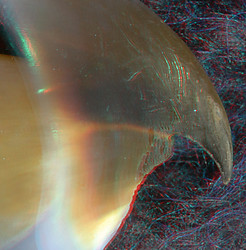 | 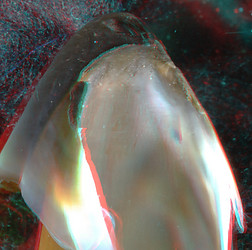 | 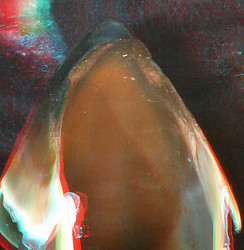 |
| Thysanoteuthis rhombus, male, 310 mm ML, 4.4 mm URL. LEFT- Side view. MIDDLE - Oblique frontal view. | T. rhombus, male, 735 mm ML, 6.7 mm URL. RIGHT - Oral view. | |
The Left image shows the absence of a Step, the presence of a Yellow Line and a convex shape to a bit the anterior edge of the Shoulder in the form of a Tooth. The Middle image shows the absence of a Palatoshoulder Ridge. The Right image is of a heavily pigmented beak which, other than the absence of a Step, doesn't reveal much about the Structure of the Shoulder.
ORDER - MYOPSIDA:
LOLIGINIDAE: - 10 genera
UPPER BEAK CHARACTERISTICS
- Step: Absent.
- Shoulder Blade: Thick; occupies outer-most major layer of Shoulder but without lateral thin layer of hyaline material.
- Shoulder Blade: Consists of two Components (Inner and Outer) separated by a distinct line in, at least, young beaks.
- Hyaline Matrix: Forms Inner (= medial) Part of Shoulder.
- Palatoshoulder Ridge: Absent.
- Pigmentation of posterior surface of Hyaline Matrix: During ontogeny pigmentation of Inner Component extends onto lateral surface of Hyaline Matrix before pigmentation of posterior Lateral Wall reaches this point. This pigment is continuous dorsally with that of the Bridge.
- Yellow line: Present. Weak in Sepioteuthis and Doryteuthis, absent in Uroteuthis. White Patch, apparently related to Yellow Line, present in Doryteuthis.
We have examined beaks of three of the four or five major clades.
Major clade 1: 1 genus
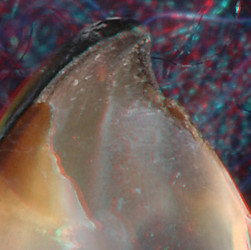 | 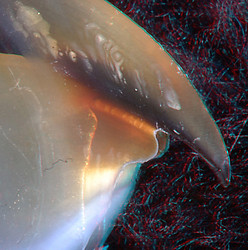 | 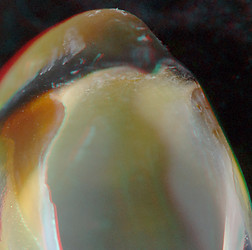 | |
| Sepioteuthis lessoniana, immature male, 64 mm ML, 1.0 mm URL. LEFT - Oblique view. | S. lessoniana, female, 155 mm ML, 2.5 mm URL. MIDDLE - Side view. RIGHT - Frontal view. | ||
The Middle image shows the absence of a Step, the presence of a Yellow Line and a convex shape of the anterodorsal edge of the Shoulder in the form of a Tooth. The Left and Right images show the absence of a Palatoshoulder Ridge in two very differently sized squid.
Major clade 2: 3 genera
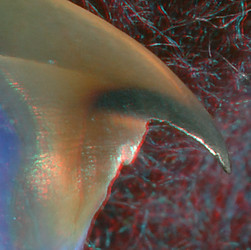 | 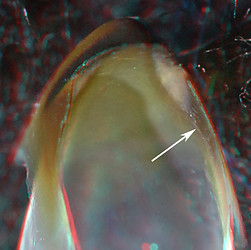 > | 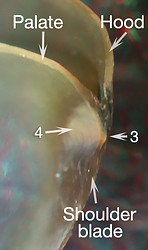 |
| Doryteuthis opalescens, mature male, 128 mm ML, 1.4 mm URL. LEFT - Side view. MIDDLE - Oblique view. RIGHT - Cross-cut through Shoulder. | ||
This beak and the next (below) look very different than the Sepioteuthis beak; the Shoulder is thin and the Free Shoulder lies close to the Sessile Shoulder. The Left image shows the absence of a Step, the presence of a weak Yellow Line and a delicate anterior edge of the Shoulder which is easily damaged resulting in an unreliable shape. In the Middle image, there is no Palatoshoulder Ridge, although, a pigmented strip (arrow) looks like one. This strip, more anteriorly and opposite the White Patch, marks the junction of the Lateral Wall/Bridge with the Hood. Opposite the Shoulder Blade, however, the apparent "Ridge" results from the termination of the Hyaline Matrix along the Shoulder Blade. The Right image, in this cross-sectional cut through the beak, shows the association between the Yellow Line (3) and the White Patch (4).
Major clade 3: 4 genera
 | 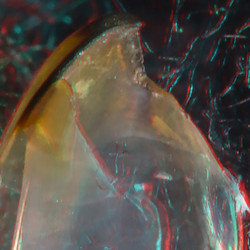 | 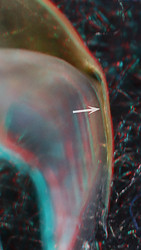 |
| Uroteuthis sp., immature male, 46 mm ML, 1.0 mm URL. LEFT - Side view. MIDDLE - Oblique view. RIGHT - Posterior view. | ||
The Left image shows the absence of a Step and Yellow Line, and the presence of a convex shape to the anterior edge of the Shoulder. The Middle image shows the absence of a Palatoshoulder Ridge and White Patch. The Right image shows the pigmentation of the Inner Component of the Shoulder Blade (arrow) extending onto the posterior Hyaline Matrix and dorsally connecting to the Bridge.
ORDER - OEGOPSIDA:
ARCHITEUTHIDAE: Architeuthis
We have not had the opportunity to cut any Architeuthis beaks and have not seen a great variety of sizes. This 1° Unipartite category for this beak, therefore, is uncertain.
UPPER BEAK CHARACTERISTICS
- Step: Absent.
- Shoulder Blade: The "outer component" of the Shoulder Blade has a thin free-edge with pieces broken off, similar to many Bipartite beaks.
- Shoulder Blade: One beak showed a possible Inner Component of the Shoulder Blade (Middle image below, arrow) in a medial view of the Shoulder.
- Hyaline Matrix: Forms Inner (= medial) Part of Shoulder.
- Palato-shoulder Ridge: None recognizable.
- Pigmentation of posterior surface of Hyaline Matrix: Only one beak had incompletely pigmented the posterior Shoulder. It showed a possible posterior extension of an Inner Component on the Shoulder Blade onto the posterior Hyaline Matrix from the junction of the Sessile and Free Shoulders.
- Yellow Line: Present. Structure unknown.
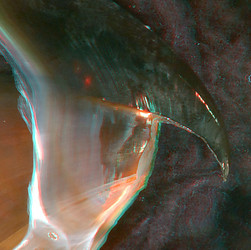 | 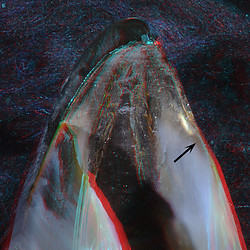 | 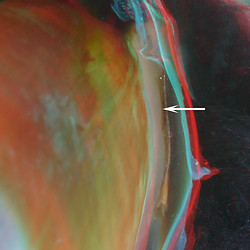 |
| Architeuthis sp., male, 1.1 m ML. LEFT - Side view of shoulder. MIDDLE - Oblique oral view of shoulder. | Architeuthis sp., immature female, 1.2 m ML, 16 mm URL. RIGHT - Posterior view. | |
The Left image shows the absence of a Step, the presence of a weak Yellow Line and a fragile anterior edge of the Shoulder which is easily damaged making its shape unreliable. The Middle image shows and absence of a Palatoshoulder Ridge and what may be an Inner Component (arrow) of the Shoulder Blade. The Right image shows pigment (arrow) on the Hyaline Matrix medial to the junction of the Free and Sessile Shoulders that could indicate the presence of an Inner Component of the Shoulder Blade.
2° Unipartite Beaks
Included here are 2 families (Sepiadariidae and Sepiolidae) of the suborder Sepiolida, with mostly small, poorly understood beaks, and the Chtenopterygidae of superfamily Bathyteuthoidea (order uncertain).
ORDER SEPIOIDEA, Suborder Sepiolida:
SEPIADARIIDAE: 2 genera
UPPER BEAK CHARACTERISTICS
- Step: Absent.
- Shoulder Blade: Rather thick; lateral (=outer) surface of Shoulder Blade without thin layer of hyaline material.
- Shoulder Blade: Consists of two components (Inner and Outer). Components separated by distinct line. Inner component may form in situ.
- Hyaline Matrix: Forms the Middle Part of the Shoulder between the Shoulder Blade and the Palatoshoulder Ridge.
- Palatoshoulder Ridge. Aparently present but reduced, limited the the dorsal region of the Shoulder.
- Pigmentation of posterior surface of Hyaline Matrix: Mechanism unknown.
- Yellow line: Absent. A "White Patch" (reflective layer), on oral surface near each jaw angle (a possible Yellow Line derivative (see: Doryteuthis, Loliginidae)), present.
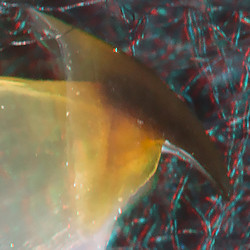 | 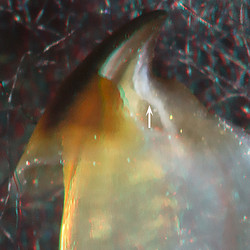 | 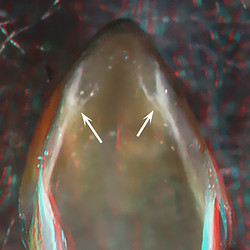 |
| Sepiadarium sp., female, 22 mm ML, Taiwanese waters. LEFT - Side view. MIDDLE - Oblique view. RIGHT - Oral-front view. | ||
The Left image shows the absence of a Step and Yellow Line and the presence of a slightly convex anterior edge of the Shoulder. The Middle and Right images show the presence of a reduced Palatoshoulder Ridge
SEPIOLIDAE - 4 subfamilies, 17 genera
UPPER BEAK CHARACTERISTICS
- Step: Absent.
- Shoulder Blade: Rather thick; lateral (=outer) surface of Shoulder Blade without thin layer of hyaline material.
- Shoulder Blade: Consists of two components (Inner and Outer). Components separated by distinct line.
- Hyaline Matrix: Apparently forms Middle Part of Shoulder in Rossinae and Heteroteuthinae (verification needed in both taxa); forms Inner (= medial) Part of Shoulder in Sepiolinae.
- Palatoshoulder Ridge: Varies from absent to remnant.
- Pigmentation of posterior surface of Hyaline Matrix: Inner Component of Shoulder Blade develops virtually simultaneously with the initial posterior pigment of the Lateral Wall (Euprymna).
- Yellow line: Absent. Absent. A "White Patch" (reflective layer), on oral surface near each jaw angle, present but may be lost in some adults.
Subfamily ROSSINAE: 4 genera
The Left image shows the absence of a Step and Yellow Line and the presence of a weakly convex anterior edge of the Shoulder. The Middle image shows a possible remnant of a Palatoshoulder Ridge (arrow) and a White Patch. The Right image from a larger R. pacifica shows no White Patch, presumably due to age.
Subfamily HETEROTEUTHINAE: 6 genera
 |  | 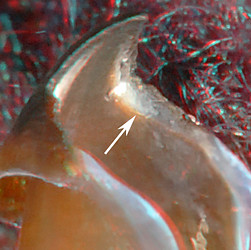 |
| Heteroteuthis hawaiiensis, mature female, 22 mm ML, Hawaiian waters. LEFT - Side view. MIDDLE - Oblique view. | Iridoteuthis sp. A, 27 mm ML, 0.8 mm URL. RIGHT - Oblique view. | |
The Left image shows the absence of a Step and Yellow Line and a rather straight anterior edge of the Shoulder. The Middle image shows what may represent the remnant of the Palatoshoulder Ridge (arrow) as the anterior Shoulder is near full pigmentation. The Right image (Iridoteuthis) shows a clear remnant of a Palatoshoulder Ridge (arrow) (note the slightly lighter color near the edge of the Ridge from light scattered off the White Patch and Hyaline Matrix).
Subfamily SEPIOLINAE: 5 genera
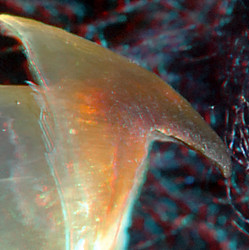 |  | 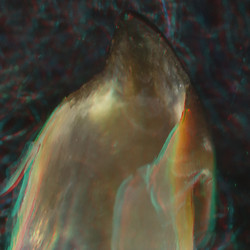 |
| Sepiola atlantica, mature female, 22 mm ML. LEFT - Side view. MIDDLE - Oblique view. | Euprymna scolopes, mature female, 26 mm ML, 1.3 mm URL. RIGHT - Oblique view. | |
The Left image of Sepiola shows the absence of a Step and Yellow line and a nearly straight anterior edge to the Shoulder. The Middle image of this virtually fully pigmented Shoulder (a superficial trace of Hyaline Matrix is present anteroventrally on the Shoulder edge) shows the remains of a ridge (arrow) in the same position as the small Palatoshoulder Ridge seen in Iridoteuthis. A White Patch is absent. The Right image (Euprymna) shows no trace of a Palatoshoulder Ridge but does have a distinct White Patch.
CHENOPTERIGIIDAE: Chtenopteryx (monotypic)
UPPER BEAK CHARACTERISTICS
- Step:The largest Chtenopteryx (1.2 mm URL) that we have seen has no step in the shoulder.
- Shoulder Blade:Thick; without thin outer (= lateral) layer of hyaline material.
- Shoulder Blade: Consists of two Components (Inner and Outer) separated by a distinct line.
- Hyaline Matrix: Forms Inner (= medial) Part of Shoulder.
- Palatoshoulder Ridge: Absent.
- Pigmentation of posterior surface of Hyaline Matrix: Mechanism unknown.
- Yellow line: Absent. White Patch absent.
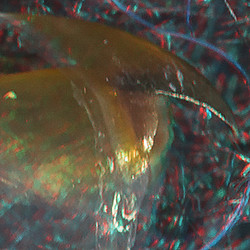 | 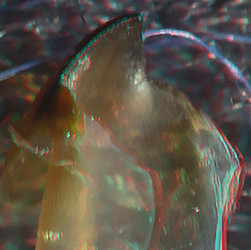 | 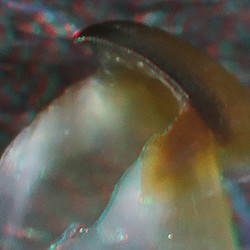 |
| Chtenopteryx sp., mature male, 32 mm ML, 0.7 mm URL. LEFT - Side view. MIDDLE - Oblique view. | Chtenopteryx sp. sex ?, immature, 35 mm ML, 0.8 mm URL. LEFT - Oblique view. | |
The Left image shows the absence of a Step and Yellow Line and a slight convexity to the anterior edge of the Shoulder. The Middle and Right images show no trace of a Palatoshoulder Ridge and no White Patches although both images give the impression of the latter due to reflective vagaries of the camera lighting angles.
3° Unipartite Beaks
Included here is a "catch-basket" of 5 families: Brachioteuthidae (in part), Joubiniteuthidae, Cranchiidae (in part), Pyroteuthidae and Lycoteuthidae (in part).
ORDER OEGOPSIDA
BRACHIOTEUTHIDAE: Slosarczykovia circumantarctica
UPPER BEAK CHARACTERISTICS:
- Step: Absent.
- Shoulder Blade: Generally thick. Occupies outer Part of Shoulder; covered laterally by very thin layer of hyaline material.
- Shoulder Blade: Consists of two Components (Inner and Outer). Inner Component forms from pigmented Lateral Wall. A line separating the Components present early but not in well-pigmented beaks.
- Hyaline Matrix: Forms Inner (= medial) Part of Shoulder.
- Palatoshoulder Ridge: None recognizable.
- Pigmentation of posterior surface of Hyaline Matrix. Ventral region of Matrix covered via intrusion of a Shoulder Pocket with Lateral-Wall pigment (extension of latter forms Inner Component of Shoulder Blade).
- Yellow Line: Absent; White Patch absent.
In the smaller beak of S. circumantarctica (Left) the Lateral Wall is about two thirds pigmented which is sufficient pigmentation for a Palatoshoulder Ridge to be present but it isn't. This pigmented area, however, extends into the Shoulder Pocket (1, 2) over the lateral surface the Hyaline Matrix onto the Shoulder Blade and leaving a dorsal, cylindrical gap between the Hood and Lateral Wall of Hyaline Matrix (3). This is the same approach used by species of the Cranchiinae in obtaining a Unipartite beak. The Middle image shows the absence of a Step and Yellow Line and a convex shape to the anterior edge of the Shoulder. In the Right image, the frontal view gives the near impression of a solid Shoulder with a Jaw-angle Pocket as is commonly seen in 1° Unipartite beaks.
JOUBINITEUTHIDAE: Joubiniteuthis portieri (monotypic)
UPPER BEAK CHARACTERISTICS
- Step: Absent.
- Shoulder Blade: Generally thin. Occupies outer Part of Shoulder; not covered laterally by thin layer of hyaline material.
- Shoulder Blade: Consists of one component.
- Hyaline Matrix: Forms Inner (= medial) Part of Shoulder.
- Palatoshoulder Ridge: Virtually absent; rudiment present.
- Pigmentation of posterior surface of Hyaline Matrix. Mostly from pigment arising at medial side of Hyaline Matrix in a typical Bipartite manner.
- Yellow Line: Absent; White Patch absent.
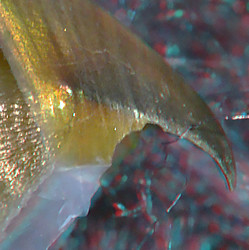 | 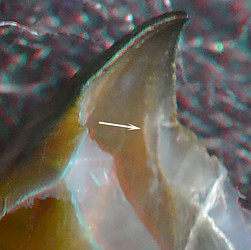 | 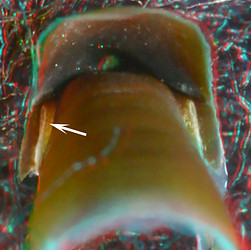 |
| J. portieri, probably male (i.e., advanced pigmentation at small size), 42 mm ML, 1.0 mm URL. LEFT - Side view. MIDDLE - Oblique view. RIGHT - Posterior view. | ||
The Left image shows the absence of a Step, no Yellow Line and an obtuse Jaw Angle (a more mature beak would have an acute Jaw Angle with a convex anterior edge to the Shoulder). The Middle image shows the absence of a Palatoshoulder Ridge although a possible rudiment of a Ridge is present (arrow). The Right image shows the nearly completed posterior pigmentation of the Hyaline Matrix (arrow) in a manner typical of Bipartite beaks.
CRANCHIIDAE: CRANCHIINAE: Cranchia, Liocranchia and Leachia
UPPER BEAK CHARACTERISTICS
- Step: Absent.
- Shoulder Blade: Thin; outermost layer of Shoulder; without partial cover by thin layer of hyaline material.
- Shoulder Blade: Consists of two (?) Components. No central "line" separating components, in longitudinal section, in well-pigmented beaks.
- Hyaline Matrix: Forms Inner (= medial) Part of Shoulder.
- Palatoshoulder Ridge: Absent.
- Pigmentation of posterior surface of Hyaline Matrix: Pigmentation begins as in Bipartite beaks but intrusion of a Shoulder Pocket with Lateral-Wall pigment covers ventral region of Matrix early-on.
- Yellow Line: Absent; White Patch absent.
The Middle image Shows the absence of a Step and Yellow Line and a Shoulder Blade with a convex anterior edge that is virtually a tooth. The Left image is a beak of a young Cranchia that shows no indication of a Palatoshoulder Ridge as would be expected with virturally no posterior Lateral Wall pigmentation. The Right image has considerable posterior Lateral Wall pigmentation with no indication of a Palatoshoulder Ridge. It has, however, a Shoulder Pocket in early development (arrow) that is covering the posteroventral Hyaline Matrix as seen in Slosarczykovia (earlier under 3° Unipartite beaks). The development of a Shoulder Pocket is seen in the younger Cranchia (Left) and in Leachia and Liocranchia below.
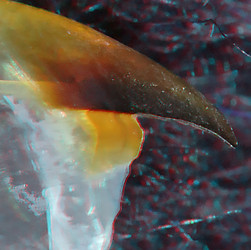 | 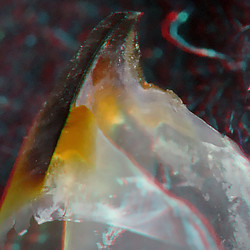 |  |
| Leachia danae, immature female, 120 mm ML, 1.3 mm URL. LEFT - Side view. MIDDLE - Oblique view. | L. danae, nearly mature female, 179 mm ML, 2.4 mm URL. RIGHT - Oblique view. | |
The Left and Middle images, without posterior Lateral Wall pigmention, look similar to the smaller Cranchia above. The Right image, however, with a nearly fully pigmented beak looks similar to that of the unrelated Slosarczykovia (seen earlier) with a beak looking similar to many 1° Unipartite beaks but having arrived there in a very different way (see 3° Unipartite Beaks page).
 | 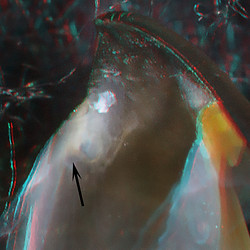 | 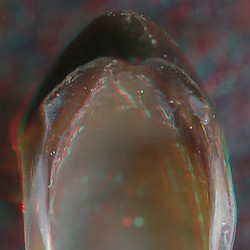 |
| Liocranchia reinhardti, sex ?, 100 mm ML, 1.4 mm URL. LEFT - Side view. MIDDLE - Oblique view. | L. reinhardti, male, 180 mm ML, 1.9 mm URL. RIGHT - Front-oral view. | |
The Left image, with a intermediate state of pigmentation, shows the absence of a Step and Yellow Line and a rather flat anterior edge of the Shoulder Blade (but note that the opposite Shoulder on the next image has a tooth). This image also shows the pigmented Shoulder Pocket overlapping the Shoulder Blade. The Middle image shows the Shoulder Pocket (arrow) from an oral view. It also shows, anterodorsal to the arrow, an irregularity in the pigmentation of the Lateral Wall that could represent a rudiment of a Palatoshoulder Ridge burried deep in the Hyaline Matrix. The Right image of a nearly fully pigmented beak looks similar to the frontal pictures of Leachia (above) and Slosarczykovia (above earlier).
PYROTEUTHIDAE: two genera
UPPER BEAK CHARACTERISTICS
- Step: Absent.
- Shoulder Blade: On Outer Part of Shoulder; without partial cover by thin layer of hyaline material.
- Shoulder Blade: Consists of one Component with possible late development of an Inner Component. No central "line" is apparent, in longitudinal section.
- Hyaline Matrix: Forms Inner (= medial) Part of Shoulder, covers most of medial remnant of Palatosholder Ridge.
- Palatoshoulder Ridge: Distinct remnant present, mostly buried within the Hyaline Matrix; composed, apparently, of several irregular layers with poorly defined boundries.
- Pigmentation of posterior surface of Hyaline Matrix: Unknown.
- Yellow Line: Absent; White Patch absent.
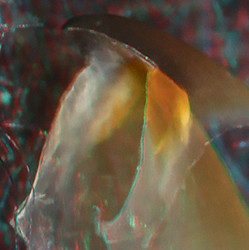 | 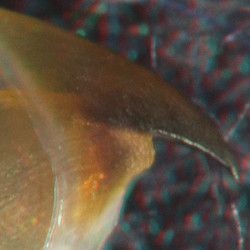 | 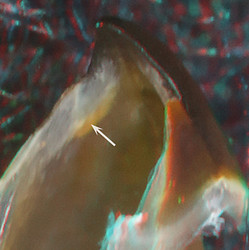 |
| Pyroteuthis addolux, immature female, 31 mm ML, 0.8 mm URL. Oblique view. | P. addolux, mature female, 38 mm ML, 0.7 mm URL. MIDDLE - Side view. RIGHT - Oblique view. | |
The Middle image shows the absence of a Step and Yellow Line and the convex shape of the anterior edge of the Shoulder Blade (i.e., a tooth). The Right image shows a remnant of the Palatoshoulder Ridge (arrow) that is back-lit indicating that it is a separate part of the Lateral Wall.
LAMPADIOTEUTHINAE: Lampadioteuthis megaleia (monotypic)
UPPER BEAK CHARACTERISTICS
- Step: Absent.
- Shoulder Blade: Moderate thickness; occupies outer part of Shoulder; not covered laterally by thin layer of hyaline material.
- Shoulder Blade: consists of two components. No central "line" separating components, in longitudinal section is apparent. The Outer component is continuous posteriorly with the Free Shoulder and the Inner Component extends posteriorly onto the Sessile Shoulder.
- Palatoshoulder Ridge: Absent.
- Hyaline Matrix: Forms Inner (= medial) Part of Shoulder.
- Pigmentation of posterior surface of Hyaline Matrix: Uncertain; Inner Component, apparently, formed in situ and extends posteriorly beyond junction of Free and Sessile Shoulders over Hyaline Matrix.
- Yellow Line: Absent; White Patch absent.
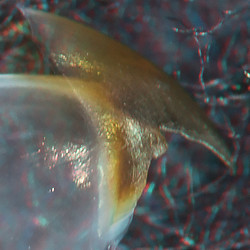 | 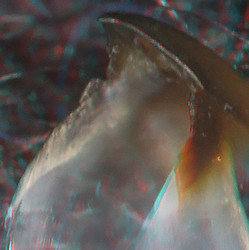 |  |
| Lampadioteuthis megaleia, female, maturity ?, 32 mm ML, 0.9 mm URL. LEFT - Side view. MIDDLE - Oblique view. | L. megaleia, mature male, 25 mm ML, 0.7 mm URL. RIGHT - Oblique view. | |
The Left image shows the absence of a Step and Yellow Line and the presence of an acute Jaw Angle and a Tooth. The Middle and Right images show no indication of a Palatoshoulder Ridge.
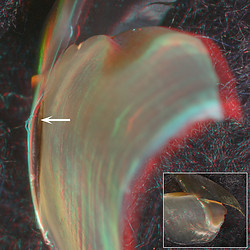
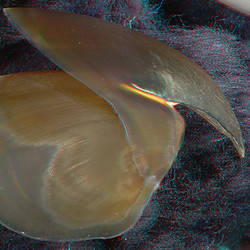
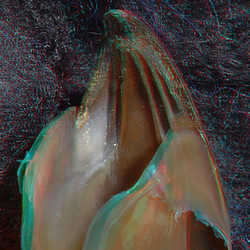
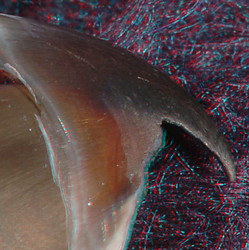
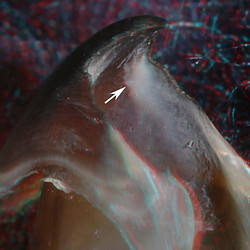
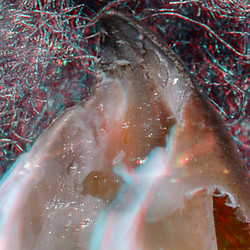
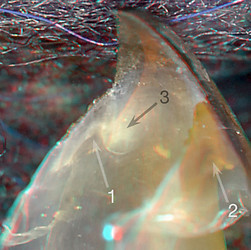
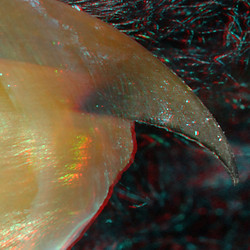
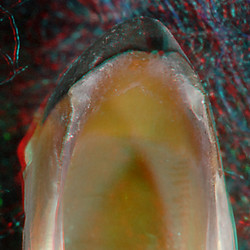
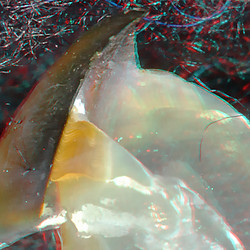
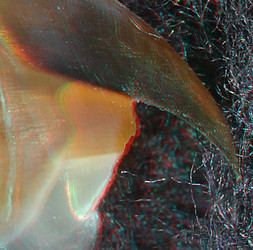
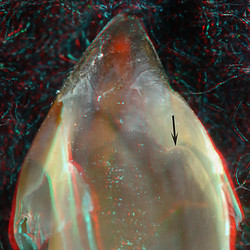


 Go to quick links
Go to quick search
Go to navigation for this section of the ToL site
Go to detailed links for the ToL site
Go to quick links
Go to quick search
Go to navigation for this section of the ToL site
Go to detailed links for the ToL site